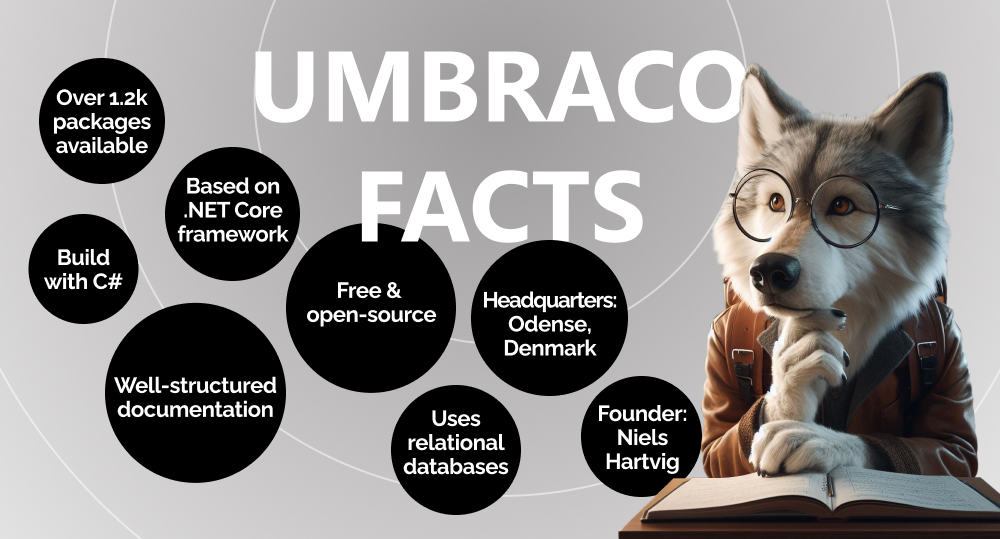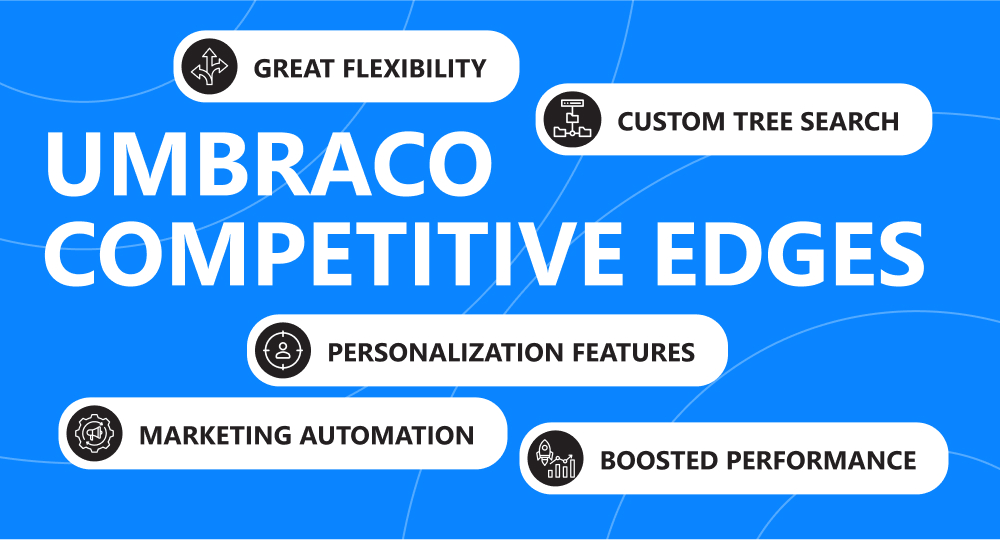If the question “What is Umbraco?” evokes your interest and you dream of a new website with rich functionality, you're hitting the right path. Being a truly flexible and user-friendly content management platform, Umbraco offers everything an ambitious site owner may desire (and even more). However, like any other solution, it has its peculiarities to consider.
In this article, we'll explore the ins and outs of the Umbraco world, as well as define whether this CMS is a wise choice for your digital contrivance. Let's kick off!
written by:
Kristina Prokopovich
Project Coordinator
If the question “What is Umbraco?” evokes your interest, and you dream of a new website with rich functionality, you're hitting the right path. Being a truly flexible and user-friendly content management platform, Umbraco offers everything an ambitious site owner may desire (and even more). However, like any other solution, it has its peculiarities to consider.
Contents
How It All Started
The era of static single-page HTML-focused websites came to an end not that long ago, as it may seem at first blush. In the early 1990s, when the world saw a website boom, unsophisticated users still had to content themselves with simplistic text pages lacking high-resolution images.
With the evolution and global spread of videography, the digital field faced buoyant demand for graphic websites. Since their manual creation, uploading, and management in multiple environments had been time-consuming and labor-intensive, soon it became clear that automation was inevitable.
In 1995, the first server-side script engines built with PHP, JSP, and ASP joined the game. But the true revolution started with the emergence of the Document Object Model (DOM) — a breakthrough programming API that allowed users to divide HTML and XML document types into constituents and treat them separately. This triggered the development of feature-rich content management systems (CMS).
CMSs have turned website development into a fun Lego game, enabling website owners to create content blocks with ready-made templates and built-in tools in double-click time.
What Is Umbraco CMS?
Umbraco is a popular content management system, written in C# and deployed on a Microsoft IIS server or in a cloud (Azure, AWS). It is created with a .NET Core framework and stores data in a relational database (like MySQL/Microsoft SQL server).
Niels Hartvig, the father of Umbraco, rolled out this friendly CMS in the early 2000s as a free solution. Since then, the platform has won the hearts and minds of architecture astronauts and weekend tech fans and gathered an extensive support community. By the way, although the platform is open-source, a fully-fledged team of in-house professionals headquartered in Denmark (Umbraco HQ) keeps a sharp eye on its performance.
And here is another amazing fact: thanks to the well-structured documentation, users can quickly find the required information (e.g., how to launch it with the Microsoft web platform installer, what Umbraco backoffice is, how to create your first document type, etc.) and get started with Umbraco in a breeze.
5 Reasons to Pick Umbraco for Your Project
At least 5k US websites are built with Umbraco. Among its active users, you may find Warner Brothers, Vogue, Mercedes-Benz, and the University of Oxford. But why exactly do Umbraco-based pages mushroom all across the internet space?
Great Flexibility Potential
It doesn't matter whether you want to create a corporate website, online store, personal blog, or corporate portal with multiple pages, as Umbraco is the unquestioned master of it all. Enriched with seamless integration options, it allows users to extend a web solution with web analytics tools (Google Analytics), CRM & ERP systems, payment gateways, and social networks.
Vast Personalization Options
Umbraco supports various languages and provides over 1.2k free packages, which gives you a large space for creativity and customization. Just choose ready-made templates built on .NET MVC (or create your own) and launch a solution aligned with your project vision. And the great news is that such functionality is available for Umbraco CMS, Umbraco Cloud, and Umbraco Heartcore.
Marketing Automation
If you need to launch a marketing campaign across several digital channels, Umbraco is there to facilitate the process. Thanks to its open nature and back-end capabilities, you can easily connect it with third-party platforms (HubSpot, Maileon) and enjoy repetitive task automation, A/B testing, 360-degree profiling, and web analytics.
Custom Tree Search
When you publish content, Umbraco provides you with versatile features to simplify the process. The most prominent are infinite editing (simultaneous management of two content pieces via a WYSIWYG editor) and searchable trees (that enable users to get search results from all accessible spaces).
Boosted Performance
High performance is Umbraco's drawcard. Content editors and developers value the platform's ability to host multiple pages on a single backend. Besides, it ensures a quick loading process even for high-traffic websites.
Peculiarities to Keep in Mind
Although Umbraco CMS has found favor with millions of users, it is still not a one-size-fits-all solution. Since its certain characteristics can turn into drawbacks for some projects, it is essential to know them by sight.
First of all, the platform may seem intricate to some users with no development experience. Particularly, they face some challenges with the installation process. Secondly, although Umbraco is powered with robust security mechanisms, timely updates and safety audits from your side are still required. And lastly, some Umbraco adopters note the insufficiency of third-party plugins to suit their projects (e.g., SEO extensions).
Alternative Content Management Systems
As you might have guessed, Umbraco is not the only player in the content management field. Scrutinize this table to learn the capabilities of other platforms.
CMS
Key Facts
Joomla
- Release date: 2005
- Developer: Open Source Matters
- Programming language: PHP
- OS: Windows, Unix-like
- Type: open-source
- Use cases: websites
- Price: free
- Distinct features: multiple templates with GUI, free documentation and video tutorials, in-built tools for SEO-optimized content, Mod_rewrite support for SEF URLs, over 70 translation packs, WYSIWYG content editor, easy core & extensions update, simplified banner/contact form/syndication/news feed management
WordPress*
- Release date: 2003
- Developer: WordPress Foundation
- Programming language: PHP
- OS: Windows, Unix-like, Linux
- Type: open-source
- Use cases: from single-page websites and mailing lists to online stores and forums
- Price: free and paid versions available
- Distinct features: hundreds of pre-designed themes and templates, intuitive block-editor, over 50k plugins, any media type is supported, post scheduling, in-built tools to optimize search engines and control access, smooth cooperation with ad publishers, automated newsletter, spam protection, backup and restore features, DDoS and WAF protection
Drupal
- Release date: 2001
- Developer: Drupal community
- Programming language: PHP, JavaScript
- OS: Windows, Unix-like
- Type: open-source
- Use cases: any type of web content
- Price: free
- Distinct features: multiple languages available, over 40k modules and 2.5k themes, rich Visual Studio, perfectly fits Docker-based environments (DDEV, Lando), reusable page layouts, clean and standards-compliant HTML5 markup, five-layer structure (data, modules, blocks & menus, permissions, templates), great flexibility
*The “Umbraco or WordPress?” question haunts a lot of undertakers, as both platforms prove to be highly customizable and user-oriented. If you are also in two minds, check our article to make a better-informed strategic decision.
Expert Tip
Umbraco is a robust platform that is ripe with opportunities for mid-size marketing agencies and small businesses. Whether it is the from-scratch development of a new site or the enhancement of the existing internet application, Umbraco CMS proves to be an excellent option.
To select the best-fit strategic path for your business, resort to our Umbraco development company. Our team will align the website with your current business needs, build lacking modules, and easily integrate it with advanced services.
Valuable Insights
A framework is the selection of tools and technologies required to build a software product. Django, Angular, Ruby-on-Rails, and .NET are well-known development frameworks. Umbraco, on the other hand, is a free, cross-platform content management system (CMS) enriched with tremendous functionalities and marketing automation tools.
Unlike many other CMS platforms, Umbraco allows you to launch a highly flexible content management strategy, easily customize the system to your current needs, and enjoy its great scalability and performance. Besides, it offers an intuitive interface that helps users manage content with ease.
Renowned for its high flexibility, Umbraco has become a go-to option for everyone who wants to create websites and mobile apps (by adapting websites to a mobile-friendly interface) with smoothly manageable content. This popular CMS supports media files in various formats (documents, audio, images, and videos) and plugins that extend its SEO potential.
Both Umbraco and WordPress are open-source CMS platforms that provide customizable templates and ensure an intuitive editing experience.
However, while WordPress is built with PHP and MySQL and is famous for vast community support and user-friendly features, Umbraco CMS offers a more flexible environment and optimal performance and is created with .NET Core.
The Umbraco platform is developed with a .NET framework. Since .NET technology is characterized by memory and type safety, object-oriented nature, and automatic memory management, Umbraco CMS ensures quick loading (even on high-traffic websites) and the ability to create linked content pages with a unique URL and back-office and data import settings.
Traditional content management systems are monolithic in structure, i.e., their back-end and front-end components act as a single unit. In a headless CMS, a backend is separated from a frontend, which ushers in scalability and faster deployment. Such systems serve as content repositories and can be connected to any digital channel (a presentation layer) via an API. Umbraco is not a headless solution, but it offers a headless version (Umbraco Heartcore) with cloud hosting.
Although open-source solutions have a license, wide user groups can easily access their codebase for further analysis and modification. This collaborative approach to software development creates vast communities around the solution. By the way, Umbraco is an open-source content management system.
Enterprises employ a digital experience platform (DXP) to keep control over the user experience they deliver across multifold digital channels. Unlike monolithic DXPs, their composable counterparts have a microservices and module approach at their core, enabling users to tailor the platform's functionality to their current needs. And the great news is that Umbraco and composable DXP setups perfectly complement each other.
Design and website creation, as well as CMS, API, and module elaboration and integration, can be a part of Umbraco development services.
If you want to scrutinize the platform's documentation, learn more about its new features, or join the Umbraco community, visit this official website.
Umbraco developers are tech artisans who visualize, create, test, launch, and update Umbraco-based websites. They know how Umbraco backend works under the hood and have experience with such programming languages as C# and HTML and the .NET framework.

Contacts
Feel free to get in touch with us! Use this contact form for an ASAP response.
Call us at +44 151 528 8015
E-mail us at request@qulix.com









